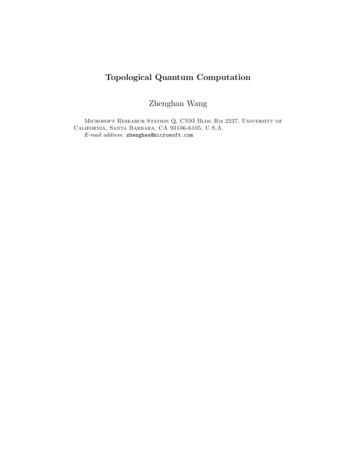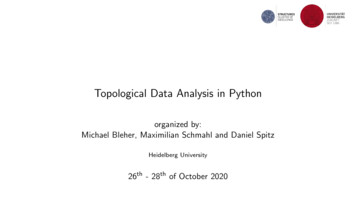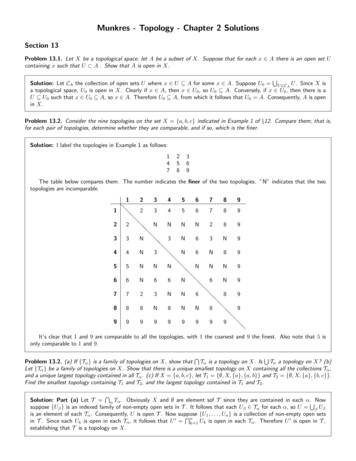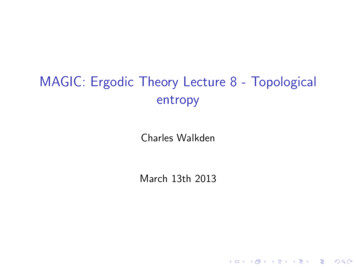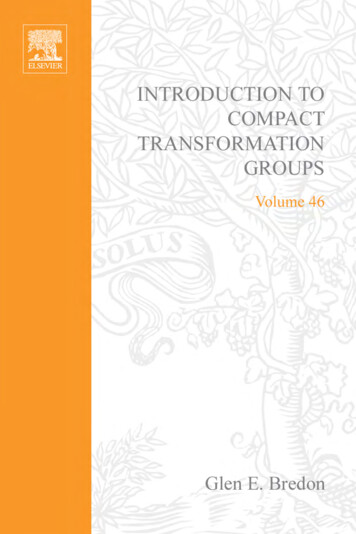
Transcription
Structural properties of Bi2Te3 topological insulator thin films grown by molecularbeam epitaxy on (111) BaF2 substratesCelso I. Fornari, Paulo H. O. Rappl, Sérgio L. Morelhão, and Eduardo AbramofCitation: Journal of Applied Physics 119, 165303 (2016); doi: 10.1063/1.4947266View online: http://dx.doi.org/10.1063/1.4947266View Table of Contents: 19/16?ver pdfcovPublished by the AIP PublishingArticles you may be interested inMagnetotransport study of (Sb1 xBix)2Te3 thin films on mica substrate for ideal topological insulatorAIP Advances 6, 055812 (2016); 10.1063/1.4943156Growth and characterization of molecular beam epitaxy-grown Bi2Te3 xSex topological insulator alloysJ. Appl. Phys. 119, 055303 (2016); 10.1063/1.4941018High-quality Bi2Te3 thin films grown on mica substrates for potential optoelectronic applicationsAppl. Phys. Lett. 103, 031605 (2013); 10.1063/1.4813903Molecular beam epitaxy of bilayer Bi(111) films on topological insulator Bi2Te3: A scanning tunneling microscopystudyAppl. Phys. Lett. 101, 081603 (2012); 10.1063/1.4747715Epitaxial growth of Bi2Se3 topological insulator thin films on Si (111)J. Appl. Phys. 109, 103702 (2011); 10.1063/1.3585673Reuse of AIP Publishing content is subject to the terms at: issions. Download to IP: 200.130.19.189 On: Thu, 02 Jun 201617:08:35
JOURNAL OF APPLIED PHYSICS 119, 165303 (2016)Structural properties of Bi2Te3 topological insulator thin films grownby molecular beam epitaxy on (111) BaF2 substrates rgio L. Morelha o,2 and Eduardo Abramof1Celso I. Fornari,1,a) Paulo H. O. Rappl,1 Se1LAS, Instituto Nacional de Pesquisas Espaciais, CP 515, 12245-970 S ao Jos e dos Campos, SP, BrazilInstituto de F ısica, Universidade de S ao Paulo, CP 66318, 05315-970 S ao Paulo, SP, Brazil2(Received 10 February 2016; accepted 9 April 2016; published online 26 April 2016)Structural properties of topological insulator bismuth telluride films grown epitaxially on (111)BaF2 with a fixed Bi2Te3 beam flux were systematically investigated as a function of substratetemperature and additional Te flux. A layer-by-layer growth mode is observed since the earlystages of epitaxy and remains throughout the whole deposition. Composition of the epitaxial filmsproduced here stays between Bi2Te3 and Bi4Te5, as determined from the comparison of themeasured x-ray diffraction curves with calculations. The substrate temperature region, where thegrowth rate remains constant, is found to be the most appropriate to obtain ordered Bi2Te3 films.Line width of the L ¼ 18 Bi2Te3 diffraction peaks as low as 140 arcsec was obtained, indicatinghigh crystalline quality. Twinning domains density rises with increasing growth temperature andreducing Te extra flux. X-ray reflectivity curves of pure Bi2Te3 films with thickness from 165 to8 nm exhibited well defined interference fringes, evidencing homogeneous layers with smooth surface. Our results demonstrate that Bi2Te3 films with very well controlled structural parameters canbe obtained. High structural quality Bi2Te3 films as thin as only eight quintuple layers grown hereare promising candidates for intrinsic topological insulator. Published by AIP TRODUCTIONBismuth telluride has long been known to have a highroom-temperature figure of merit (ZT) among the thermoelectric materials.1–3 Recently, it has attracted intense interest due to its pronounced features as a member of a newclass of materials called three-dimensional topological insulators, which are insulating in the bulk and exhibit gaplessmetallic surface states with linear energy-momentum dispersion shaped like a Dirac cone. Due to the strong spin-orbitcoupling, these conducting surface states have electronmomentum locked to the spin orientation and are protectedfrom scattering mechanisms by time reversal symmetry.Consequently, high-mobility spin polarized surface currentscan be produced without external magnetic fields, offeringpossibilities to new applications in spintronics or quantumcomputing.4–6The topological order in V-VI compounds has beentheoretically predicted7–9 and the existence of the metallicsurface states has been confirmed by angle resolved photoelectron spectroscopy (ARPES) experiments in bulk singlecrystals of Bi1 xSbx,10 Bi2Se3,11,12 Sb2Te3, and Bi2Te3.13,14ARPES has demonstrated to be a powerful technique tocharacterize the conducting surface states, providing theexperimental signature of a three-dimensional topologicalinsulator. The bulk samples are cleaved inside the vacuumchamber in order to obtain a fresh surface for ARPES and,even in ultra high vacuum (UHV) conditions, aging effectshave been reported.15,16 The oxide layer formed by air exposure on the V-VI crystal surface degrades the metallic states.a)Author to whom correspondence should be addressed. Electronic mail:celso.fornari@inpe.br. Tel.: þ55 12 3208-6681.0021-8979/2016/119(16)/165303/9/ 30.00In case of Bi2Te3, an oxide layer of 1 nm is formed afteraround 1 day at room conditions.16,17 The contribution of theDirac surface states to electrical conductivity measurementsis hindered by bulk conduction due to free carriers producedby crystalline defects like vacancies and anti-sites in theV-VI alloys. Besides surface oxidation, this bulk conductionhampers electrical measurements of the metallic surfacestates in three-dimensional topological insulators. Counterdoping, like Ca for Bi2Se311 and Sn for Bi2Te3,14 has beenused to move the Fermi level inside the band gap to obtaininsulating bulk samples. However, high doping affectscarrier transport and conduction only through topologicalsurface states has shown instabilities in time scale of hoursduring ARPES experiments.18 In order to obtain intrinsic topological insulators, molecular beam epitaxy (MBE) has beenapplied to grow bismuth chalcogenide layers. Due to thecontrol at the atomic level and reproducibility of the MBEtechnique, high structural quality bismuth chalcogenide filmsare obtained, where the bulk conduction is expected to besuppressed.Epitaxial films of bismuth telluride have been grown byMBE on different types of substrates like (111) Si, (111)GaAs, and (0001) Al2O3.19–22 In case of the Bi2Te3 epitaxyon (111) Si, a small lattice mismatch near to 1% is found if asupercell of both materials is considered, which enables thegrowth of high crystalline quality films.19 Despite the largelattice mismatch to Bi2Te3 of 8.7% for both GaAs andAl2O3, epitaxial layers with relatively good structural qualityhave been achieved on these substrates as van der Waalsbonds inside Bi2Te3 crystal structure accommodate the inplane differences in lattice parameters.22 Due to the smalllattice mismatch of only 0.04% to Bi2Te3, (111) BaF2 has119, 165303-1Published by AIP Publishing.Reuse of AIP Publishing content is subject to the terms at: issions. Download to IP: 200.130.19.189 On: Thu, 02 Jun 201617:08:35
165303-2Fornari et al.J. Appl. Phys. 119, 165303 (2016)been shown to be an appropriate substrate to grow bismuthtelluride.23–25 The films can be grown by MBE using eitherseparated Bi and Te solid sources19–23 or a Bi2Te3 compoundeffusion source and additional Te cell.24,25 Depending on thegrowth parameters, other phases of BixTey compounds canbe obtained and the conditions to achieve single phaseBi2Te3 are located in a narrow window. Most recently,intrinsic conduction through topological surface states hasbeen reported for very thin (10–50 nm) insulating Bi2Te3 epitaxial films, as demonstrated by ARPES and four-point probeconductivity measurements performed at room temperaturein the same UHV system. However, conduction throughDirac surface states vanishes after air exposure in time scaleof minutes, indicating that a capping layer is essential to protect topological state and explore these new features in roomconditions.26 Determination of optimum growth parametersto obtain high-quality Bi2Te3 epitaxial layers with well controlled structural properties is therefore crucial for practicalapplications.Contrary to conventional zinc-blend and rock-salt semiconductor compounds, bismuth telluride can exist in different BixTey phases, depending on the growth conditions. TheBixTey compounds constitute a homologous series of crystalstructures derived from an ordered stacking of Te1-Bi-Te2Bi-Te1 quintuple layers (QLs) and Bi-Bi bilayers (BLs)building blocks, forming the (Bi2)M(Bi2Te3)N adaptativeseries27 shown in Figure 1. This series spans from theTe-richest phase Bi2Te3 (M:N ¼ 0:3) to pure bismuth(M:N ¼ 3:0), passing through a series of phases such asBi4Te5 (M:N ¼ 1:5), Bi6Te7 (M:N ¼ 2:7), Bi8Te9(M:N ¼ 3:9), BiTe (M:N ¼ 1:2), and Bi4Te3 (M:N ¼ 3:3).The entire series can be written in terms of the Te deficit d asBi2Te3-d, where d ¼ 3 M/(M þ N). Except in the limitingcases, d ¼ 0 and d ¼ 3, the addition of Bi-Bi bilayers inbetween the quintuple layers during molecular beam epitaxial growth does not occur uniformly, but as a statisticaldistribution where the grown films can be considered as arandom one-dimensional BixTey alloy rather than as an ordered homologous (Bi2)M(Bi2Te3)N structure.25Like other V-VI compounds, Bi2Te3 crystallizes in atetradymite-type structure shown in Figure 2(a). The unitcell of this hexagonal lattice is described by stacking of threeTe1-Bi-Te2-Bi-Te1 quintuple layers along c-direction. Insidethe QL, the neighboring Bi-Te atoms are ionic bonded andthe adjacent QLs are van der Waals coupled to each other bythe facing Te1-Te1 layers. This van der Waals gap gives thestructure an anisotropic character similar to other layeredmaterials. The lattice parameter along [0001] direction of theBi2Te3 bulk material is c ¼ 30.474 Å. Figure 2(b) shows the(0001) Bi2Te3 surface with the three topmost atomic layers,which form a hexagonal lattice with an in-plane lattice parameter a ¼ 4.382 Å. The atomic rows along the symmetryazimuths ½11 20 and ½10 10 , rotated by 30 to each other, areseparated by a 2冑3 and a 2, respectively. As the in-plane¼ aBaF2 lattice constant of the (111) BaF2 surface aBaF20jj冑2 ¼ 4.384 Å is almost equal to the hexagonal lattice constantof Bi2Te3, the small lattice mismatch of only 0.04% betweenboth materials makes (111) BaF2 a suitable substrate for theepitaxy of bismuth telluride. In this epitaxy, the (0001)Bi2Te3 hexagonal planes are parallel to the (111) cubic BaF2planes and the ½ 110 azimuth of the substrate cubic lattice isparallel to the ½11 20 azimuth of the film hexagonal lattice.This work presents a systematic investigation of thestructural properties of bismuth telluride thin films grown bymolecular beam epitaxy on (111) BaF2 substrates, using anominal stoichiometric Bi2Te3 solid source and additionalFIG. 1. Crystal structure representation of BixTey compounds in the orderedhomologous (Bi2)M(Bi2Te3)N series: (a) Bi2Te3, (b) Bi4Te5, (c) BiTe, (d)Bi4Te3, and (e) Bi. Building blocks of Bi2Te3 quintuple layers and Bi2bilayers are shown in violet and red, respectively. The entire series can beexpressed as Bi2Te3–d, where d ¼ 3M/(M þ N) is the Te deficit. The latticeperiodicity of each compound is indicated aside.27FIG. 2. (a) Hexagonal crystalline structure of Bi2Te3. The unit cell is formedby stacking of three Te1-Bi-Te2-Bi-Te1 quintuple layers (QL) along [0001]direction. The van der Waals (vdW) coupling between adjacent QLs throughTe1 atoms is much weaker than that between Te-Bi inside the QL. (b)(0001) Bi2Te3 surface showing the three uppermost atomic layers, evidencing the hexagonal unit cell with lattice parameter a and the three symmetryazimuths.Reuse of AIP Publishing content is subject to the terms at: issions. Download to IP: 200.130.19.189 On: Thu, 02 Jun 201617:08:35
165303-3Fornari et al.Te cells. The growth conditions were varied in a wide rangeof substrate temperature and Te/Bi2Te3 beam flux ratio.The epitaxial films were characterized in situ by reflectionhigh-energy electron diffraction (RHEED) and ex situ byhigh-resolution x-ray diffraction, x-ray reflectometry, andfield-emission gun microscopy.EXPERIMENTALBismuth telluride epitaxial films were grown on freshlycleaved (111) BaF2 substrates, from Korth Kristalle GmbH,in a Riber 32P molecular beam epitaxial system using aneffusion cell charged with nominal stoichiometric Bi2Te3solid source and two additional Te cells to offer the extraTe flux. The Bi2Te3 charge was synthesized in our laboratoryfrom commercially available Bi (99.999%) and Te(99.9999%) elemental materials. For all growths, four thinsubstrate slices were fixed with an eutectic indium-galliumsolution to the molybdenum substrate holder. The beamfluxes were monitored by a Bayer-Alpert ion gauge movedto the substrate position before and after each growth. Thebeam equivalent pressure (BEP) of the Bi2Te3 and Te fluxeswas measured and the flux ratio UR ¼ BEPTe/BEPBi2Te3 wasdetermined. The BaF2 substrates were pre-heated at 300 Cfor 10 min before starting the growth. The background pressure of the growth chamber was maintained at 10 9 Torr during growth.To monitor in situ the film surface during growth, reflection high-energy electron diffraction (RHEED) patterns wereacquired using a 35 keV RHEED system equipped with aCCD camera in front of the fluorescent screen and a dataacquisition setup. The kSA 400 software package was usedto analyze the recorded RHEED movies.X-ray diffraction measurements were performed in aPANalytical X0 Pert MRD high-resolution x-ray diffractometer equipped with (220) Ge four-crystal monochromatoradjusted for Cu Ka1 radiation and an open detector withacceptance of 1 . For the twinning characterization, the sameconfiguration of the x-ray diffractometer is used to performazimuthal scans for a fixed Bi2Te3 asymmetric Bragg peak.To measure the grazing incidence x-ray reflectivity ofBi2Te3/BaF2 films, the high-resolution x-ray diffractometerconfiguration is changed. In this configuration, the Cu x-raytube is set to line focus and the incident beam optics is composed of a Soller slit with an axial divergence of 2.5 , a1/32 divergence slit, a Ni filter, and an attenuator, and forthe reflected beam of a parallel beam collimator, a 0.1 mmanti-scatter slit and a flat-crystal graphite monochromator.Cross section images of Bi2Te3/BaF2 films wereacquired using a TESCAN MIRA3 field-emission gun microscopy equipped with an energy dispersive x-ray detector.J. Appl. Phys. 119, 165303 (2016)2. The thickness of the films was measured by interferencefringes in x-ray reflectivity curves and/or by field-emissiongun microscopy cross section images. The growth time forall samples was 2 h, except for the series produced to x-rayreflectivity analysis.The behavior of the growth rate as a function of substrate temperature for different UR can be divided in threeregions as shown in Figure 3. At low substrate temperaturesnear 180 C, where the re-evaporation rate of Te is too low,all extra Te atoms practically stick to the surface, leading tohigher growth rates up to 0.9 Å/s. As the temperature rises to220 C in region A, the Te re-evaporation rate increases andthe growth rate resembles the sticking coefficient curve oftellurium.28 In the intermediate region B, for substratetemperatures between 220 C and 280 C, the exceeding Teatoms have sufficient energy to re-evaporate and the growthdynamics allows the Bi and Te atoms to accommodate intheir sites. Therefore, the growth rate remains almost constant at around 0.2 Å/s and is only determined by the Bi2Te3cell temperature. For substrate temperatures higher than280 C (region C), the growth rates start to decrease and vanish at TSUB 300 C for UR ¼ 0 and at TSUB 310 C forUR ¼ 1, due to the decrease of Bi sticking coefficient.28Contrary to region B, where the growth rate is independentof UR, the reduction of the growth rates in region C is morepronounced for lower UR.Reflection high energy electron diffractionThe reciprocal of the hexagonal surface lattice shown inFigure 2(b) is also a hexagonal lattice rotated by 30 with alattice parameter of 4p a冑3. In this sense, the symmetryazimuths during RHEED measurements are gyrated by 30 in relation to those shown in Figure 2(b). All RHEED patterns were measured with an energy of 16 keV.In order to investigate the initial stages of the epitaxy ofBi2Te3 on (111) BaF2, RHEED patterns were recorded during the first minutes of growth. Figure 4(a) shows the streakyRHEED pattern of the BaF2 substrate along the ½ 101 RESULTS AND DISCUSSIONMolecular beam epitaxyFor this work, a series of samples was produced with thebeam equivalent pressure of the Bi2Te3 cell kept constant at5 10 7 Torr and varying the substrate temperature between180 C and 310 C and the Te/Bi2Te3 flux ratio UR from 0 toFIG. 3. Growth rate as a function of substrate temperature for flux ratioUR ¼ 0 and 1. In region A, the growth rate decreases from 0.9 to near 0.2 Å/sresembling the Te sticking coefficient temperature behavior. Between 220and 280 C, region B, a constant growth rate is achieved regardless of theextra Te flux. Above 280 C in region C, the growth rates start to reduce dueto the decreasing Bi sticking coefficient and vanish above a certain temperature depending on UR. All films were grown during 2 h.Reuse of AIP Publishing content is subject to the terms at: issions. Download to IP: 200.130.19.189 On: Thu, 02 Jun 201617:08:35
165303-4Fornari et al.J. Appl. Phys. 119, 165303 (2016)FIG. 4. RHEED patterns acquired during the epitaxy of Bi2Te3 on (111)BaF2 substrate: (a) BaF2 surface justbefore growth and for increasingBi2Te3 film coverage after (b) 0.2 QL,(c) 1 QL, and (d) 10 QLs of depositionand at the end of growth with 165 QLsfor both (e) ½2 1 10 and (f) ½10 10 azimuths.azimuth just before growth, evidencing a flat surface. TheRHEED patterns along the ½2 1 10 azimuth of the (0001)Bi2Te3 film after 0.2 QL, 1 QL, and 10 QLs of deposition areshown in Figures 4(b)–4(d), respectively, for a sample grownat substrate temperature of 240 C and flux ratio UR ¼ 1. Thestreaks of the Bi2Te3 layer pattern start to be formed alreadywith 0.2 QL of deposition. They become more elongatedwith 1 QL of coverage and, for a thickness of 10 QLs, thestreaky RHEED pattern is completely formed with clearlydefined Kikuchi lines. RHEED images with well definedstreaks confirm the layer-by-layer growth mode since theearly stages. The RHEED pattern measured along the ½2 1 10 azimuth for the film with 165 QLs at the end of growth,shown in Figure 4(e), is identical to the one measured with10 QLs, indicating that the growing surface has the samecharacteristics throughout the whole deposition. TheRHEED image measured along the ½10 10 azimuth, at theend of growth, for the same sample is shown in Figure 4(f)and also exhibits a streaky pattern with Kikuchi lines withoutintermediate streaks, confirming the absence of surfacereconstruction for this epitaxy. Similar results were observedfor all samples grown with substrate temperatures higherthan 220 C and for all flux ratios.The Bi2Te3 films grown on region A exhibit a roughsurface with Te agglomerates, as determined from energydispersive x-ray field-emission gun microscopy analysis andbroad x-ray diffraction peaks characteristic of films withpoor crystalline quality and mixed phases. Therefore, theinvestigation in region A was not expanded to other fluxratios than UR ¼ 1. The ex situ characterization results arepresented in the next sessions for the films grown withTSUB 220 C (regions B and C).X-ray diffractionFor all samples, x/2H scans were recorded in a widerange of 2H, from 4 to 104 . Figure 5(a) shows the x-raydiffraction curves in terms of the reciprocal space coordinatealong the [0001] direction (Qz) for films grown with fixedflux ratio UR ¼ 1 and varied substrate temperature from220 C to 300 C, while Figure 5(b) displays them for a fixedTSUB ¼ 280 C and UR ranging from 0 to 2. For all measureddiffraction curves, besides the (111), (222), and (333) BaF2substrate Bragg peaks, only the (000L) Bi2Te3 symmetricaldiffraction peaks are observed, as expected for epitaxyoccurring with the (000L) Bi2Te3 hexagonal planes parallelto the (111) BaF2 surface.For increasing substrate temperature at a fixed flux ratio,the (000L) x-ray diffraction peaks shift, become broader, oreven split. This behavior is more pronounced for the Bi2Te3peaks with L ¼ 18 and L ¼ 21 and the expanded views of thediffraction curves around these maxima are shown in Figures5(c) and 5(d), respectively. As TSUB rises from 220 C to300 C for UR ¼ 1, the (00018) Bi2Te3 peak slightly shifts tolower Qz in direction to the peak position of the (00014)BiTe phase (red vertical line in Figure 5(c)), while the(00021) Bi2Te3 Bragg peak moves to higher Qz valuestowards the (00017) BiTe peak (red vertical line in Figure5(d)), tending to Bi-rich phases. At lower substrate temperatures (TSUB 250 C), the x-ray diffraction curves do notpresent a significant change as a function of flux ratio. Onthe other hand, for higher substrate temperatures, the effectof the flux ratio variation on the x-ray curves is easilynoticed. The influence of the extra Te flux is illustrated inFigures 5(e) and 5(f), where the expanded views in the vicinity of the L ¼ 18 and 21 Bi2Te3 peaks are represented. Thelarge Te desorption at the elevated TSUB of 280 C is compensated by increasing UR and plain Bi2Te3 phase is recovered for UR ¼ 2.It is important to stress out that the BixTey films grownin this work on (111) BaF2 substrates, using a nominalBi2Te3 solid source and extra Te cell, never presented pureBiTe phase even without offering additional Te flux (UR ¼ 0)and at the highest TSUB ¼ 300 C (for TSUB 300 C, no deposition is observed at all). These results are different frompreviously published,24,25 where BixTey epitaxial film withcomposition ranging from BiTe to Bi2Te3 was obtained byvarying only the exceeding Te flux. This fact can beexplained by a variation in the stoichiometry of the Bi2Te3solid sources used in the different MBE machines.To investigate the effect of the Te deficit in the Qz scans,reflection and transmission coefficients of stacking sequences of QLs and BLs were calculated by using a set of recursive equations29 that accounts for absorption, refraction, andrescattering events in the film, as well as in the substrate lattice. Figure 6 shows the calculated diffraction curves for anordered Bi2Te3 film with 165 QLs and for an ordered Bi4Te5film with 33 Bi2 BLs inserted in between 165 QLs. TheReuse of AIP Publishing content is subject to the terms at: issions. Download to IP: 200.130.19.189 On: Thu, 02 Jun 201617:08:35
165303-5Fornari et al.J. Appl. Phys. 119, 165303 (2016)FIG. 5. Wide angular x/2H scans ofBi2Te3 epitaxial films grown on (111)BaF2 at (a) different substrate temperatures TSUB and fixed flux ratio UR ¼ 1and (b) at varied flux ratio UR from 0 to2 and fixed TSUB ¼ 280 C. (c)–(f)Expanded view of the scans around theL ¼ 18 and L ¼ 21 Bi2Te3 peaks. Blueand red vertical reference lines indicatethe expected peak positions for epitaxialfilms of Bi2Te3 and BiTe, respectively.diffraction pattern of the ordered Bi4Te5 film is quite different from that of the Bi2Te3, indicating that all films havestructures close to Bi2Te3-d with d 0.5. The peak nearQz ¼ 3.1 Å 1 (L ¼ 15 in the Bi2Te3 structure) shifts according to Qz ¼ 2p/hDzi, where the mean inter-plane atomic distance hDzi is given byhDzi ¼ 2:035 0:025 d ðÅÞand accounts for contributions of both composition andstrain variations for epitaxial films on (111) BaF2.25 Itimplies that the Bi2Te3 (M:N ¼ 0:3), Bi4Te5 (M:N ¼ 1:5),and BiTe (M:N ¼ 1:2) films have lattice periodicities of30.525 Å (¼15 hDzi), 54.608 Å (¼27 hDzi), and 24.120 Å(¼12 hDzi), respectively. The other effect that can be verified by the simulation as a consequence of small Te deficit(d 0.5) is the splitting of the L ¼ 21 peak into two peaks ofnearly the same intensity, which is roughly given byDQz 0:23dðÅÞ:FIG. 6. Calculated x-ray diffraction curves for ordered Bi2Te3 (with 165QLs) and Bi4Te5 (with 33 BLs periodically inserted in 165 QLs) films on(111) BaF2 substrate.(1)(2)The L ¼ 18 also splits by the same amount, but one of thepeaks is weaker than the other with the stronger peak shiftingto the left.Figure 7(a) shows the hDzi values obtained from theL ¼ 15 peak position as a function of the substrate temperature for UR ¼ 0, 1, and 2. By comparing with the expectedhDzi values for epitaxial films of phases from Bi2Te3 toBiTe (reference lines in Figure 7(a)), it is easy to notice thatthe films start to deviate from Bi2Te3 to Bi-richer phases forsubstrate temperatures higher than 250 C when UR ¼ 0 and1. For higher additional Te flux (UR ¼ 2), the measured hDzivalues indicate that stoichiometric Bi2Te3 epitaxial films areReuse of AIP Publishing content is subject to the terms at: issions. Download to IP: 200.130.19.189 On: Thu, 02 Jun 201617:08:35
165303-6Fornari et al.FIG. 7. (a) Mean inter-plane atomic distance hDzi as a function of substratetemperature. Reference values (dashed lines) of a few phases are also shownfor sake of comparison. (b) Full-width at half maximum (FWHM) of the(00018) Bi2Te3 Bragg peak for different flux ratios UR.J. Appl. Phys. 119, 165303 (2016)Figure 8 shows the azimuthal scans for films grown attwo substrate temperatures. The major peaks at / ¼ 0 , 120 ,and 240 , labeled as A, correspond to the three-fold symmetry of the Bi2Te3 structure shown in Figure 2(b), evidencingthat the ½11 20 azimuth of the film hexagonal lattice is parallel to the ½ 110 azimuth of the substrate cubic lattice. Theazimuthal scans also show additional peaks at / ¼ 60 , 180 ,and 300 , labeled as B, corresponding to twinned domainsrotated by 180 . The twinning degree can be expressed bythe mean intensity ratio between both peaks, TwD ¼ hIBi/hIAi. Values of TwD close to zero indicate small portion oftwinned domains, while TwD values close to one mean thatthe quantity of twinned domains is practically equal to theuntwinned regions. Here, all twinning analyses were madeon pure Bi2Te3 epitaxial films (hDzi ¼ 2.035 6 0.002 Å).Figure 9(a) plots TwD as a function of substrate temperaturefor different values of UR ¼ 0, 1, and 2. One can observe thatthe twinning degree increases for increasing growth temperature and is lower for higher extra Te offer. The lowest TwDvalues near 0.01 were obtained at a growth temperature of220 C and flux ratio UR ¼ 1. Twinning domains of hexagonal crystals with ABCABC stacking, like Bi2Te3, are formedby a change in the stacking sequence in different regions ofthe sample during epitaxial growth. Usually, higher energiesare needed to generate twinning domains, since this stackingfault is energetically less favorable. Therefore, lower growthtemperatures favor single domain films, as observed here. Ata fixed substrate temperature (constant kinetic energy), theachieved up to TSUB of 280 C. According to this, the composition of the BixTey epitaxial films reported in this workstays between Bi2Te3 and Bi4Te5, i.e., with the Te deficitd 0.5. Shifting and splitting of the L ¼ 18 and L ¼ 21 peaksare also observed in the films with higher d values. Forinstance, the film grown at TSUB of 280 C and UR ¼ 1, thesplitting of the L ¼ 21 peak is about DQz ¼ 0.056 Å 1(Figure 5(d)), providing an estimated Te deficit d ¼ 0.24 (Eq.(2)), which agrees very well with d ¼ 0.20 (Eq. (1)) obtainedfrom hDzi ¼ 2.030 Å (Figure 7(a)).The crystalline quality of the grown films can be evaluated by the width of the (00018) Bi2Te3 x-ray diffractionpeak. The x-scan around the (00018) peak was measured forall samples and its full-width at half-maximum (FWHM) isdisplayed in Figure 7(b) as function of substrate temperatureand flux ratio. For UR ¼ 1, the FWHM increases monotonically from 150 arcsec to 600 arcsec as TSUB rises from220 C to 300 C, while without extra Te flux, the crystallinequality gets worse as it increases from 200 arcsec to valueshigher than 1000 arcsec in the same temperature range. Asthe flux ratio increases to UR ¼ 2, the FWHM remains below300 arcsec up to TSUB ¼ 280 C.Twinning characterizationTo investigate the epitaxial relations of the Bi2Te3 filmson (111) BaF2 substrates, azimuthal scans from 0 to 360 were measured for the fixed ð01 15Þ asymmetric x-ray diffraction peak. FIG. 8. Azimuthal scans for a fixed ð0115Þasymmetric x-ray diffractionpeak for Bi2Te3 films grown at two different substrate temperatures andfixed flux ratio of 1. The major peaks labeled A correspond to the three-fold20 azimuth parallel to thesymmetry of Bi2Te3 hexagonal lattice, with its ½11 ½ 110 direction of the BaF2 substrate. The peaks labeled B are relative totwinned domains rotated by 180 .Reuse of AIP Publishing content is subject to the terms at: issions. Download to IP: 200.130.19.189 On: Thu, 02 Jun 201617:08:35
165303-7Fornari et al.J. Appl. Phys. 119, 165303 (2016)FIG. 10. Measured x-ray reflectivity curves (open circles) of Bi2Te3/BaF2films grown at fixed substrate temperature TSUB ¼ 240 C and flux ratioUR ¼ 1 with decreasing deposition time: (a) 120, (b) 36, (c) 18, and (d)7 min, leading to a series with varied thickness. The solid lines are calculatedcurves that best fitted to the measured data. The values of layer thicknessand roughness extracted from the best fits are displayed in the graphs.FIG. 9. Twinning degree (TwD) of the Bi2Te3 films as a function of (a) substrate temperature for different flux ratios UR ¼ 0, 1, and 2, (b) flux ratio URat a
Structural properties of Bi 2Te 3 topological insulator thin films grown by molecular beam epitaxy on (111) BaF 2 substrates Celso I. Fornari,1,a) Paulo H. O. Rappl,1 Sergio L. Morelhao, 2 and Eduardo Abramof1 1LAS, Instituto Nacional de Pesquisas Espaciais, CP 515, 12245-970 Sao Jos e dos Campos, SP, Brazil 2Instituto de Fısica, Universidade de Sao Paulo, CP 66318, 05315-970 S ao Paulo, SP .


